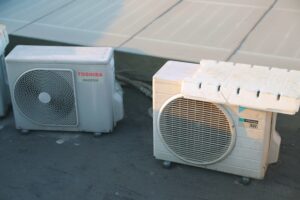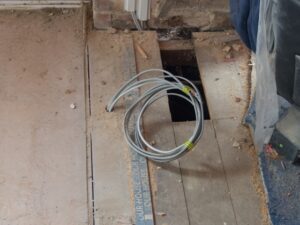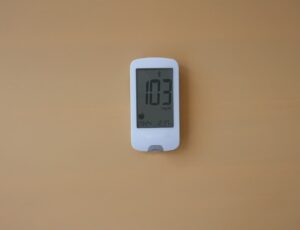Experiencing low water pressure after replacing your water heater can be frustrating, right?
You’ve gone through the hassle of installing a new unit, expecting better performance, and now you’re facing water pressure issues.
Well, don’t worry!
Before calling for professional help, there are several simple steps you can take to troubleshoot and potentially fix the problem yourself.
Start by checking for clogs in your pipes or sediment buildup — these are some of the most common culprits behind low water pressure after installing a new water heater. Ensuring proper installation and adjusting the valves might solve the problem quickly.
If these steps don’t improve things, it might be time to inspect the pressure regulator.
But, if you’ve already tried the basics and are still facing issues, calling in the pros might be the best option. And who is better than Excel Mechanical?
We specialize in both residential and commercial HVAC and plumbing services. Our team is dedicated to delivering exceptional quality and ensuring your system works efficiently without costing you a fortune.
Whether you’re facing water pressure issues or need a complete system overhaul, we work with you to meet your individual needs and budget. You can count on us for both high-quality service and excellent value.
In this blog, you will learn:
- Common causes of low water pressure after installing a new water heater.
- How to troubleshoot and resolve water pressure issues yourself.
- When it’s time to consult a professional like Excel Mechanical for expert help.
Let’s dive in!
Understanding Water Pressure Issues
Issues with water pressure can be frustrating, especially when you notice them after replacing a water heater. Understanding water pressure and the reasons behind any changes can help address these problems.
This section defines water pressure and explores the common causes behind low levels.
Defining Water Pressure
Water pressure refers to the force that pushes water through pipes and into your home.
It’s essential to ensure showers are satisfying, faucets run smoothly, and appliances operate effectively. Measured in pounds per square inch (PSI), typical household water pressure ranges from 40 to 60 PSI. Values within this range provide efficient water flow without undue stress on pipes.
When water pressure falls below 40 PSI, you might experience slow water flow or delayed appliance functions. Conversely, pressure above 60 PSI can lead to wear and tear on plumbing fixtures.
Knowing the ideal range to maintain a balance that meets your household needs while protecting plumbing is essential.
Common Causes of Low Water Pressure
Several factors can lead to low water pressure.
- One common cause is clogged pipes, often due to mineral buildup or debris. Over time, these blockages reduce water flow and pressure.
- Another cause can be a malfunctioning pressure regulator, which can be checked and replaced if necessary.
- Leaky pipes are another significant factor, leading to water loss and decreasing pressure. To avoid this issue, inspect your plumbing system regularly for any leakage signs.
- After replacing a water heater, sediment buildup within the heater might block water flow, affecting pressure.
Assessing the Water Heater Installation
To ensure your new water heater is working as intended, you must verify the installation was done properly and check that the settings are correct. Attention to detail at this stage can prevent issues like low water pressure.
Checking for Proper Installation
Start by examining the physical setup of your water heater.
Ensure all connections are secure, without visible leaks or loose fittings. Valves and pipes should be correctly aligned and tightly attached to avoid potential leaks or water pressure problems.
Next, inspect the venting system. Proper ventilation is crucial for gas water heaters to function safely and efficiently. Make sure the vent pipes are the right size and slope upwards.
Verify the water heater is level. A tilted unit can cause inefficiencies. Use a spirit level to check the balance and make adjustments if necessary.
Ensuring Correct Water Heater Settings
Now, review the settings on your water heater.
Adjust the thermostat to the recommended temperature, usually around 120°F. This ensures safe water temperatures while maintaining energy efficiency.
Check the pressure relief valve, ensuring it is functional and properly attached. This valve helps manage pressure buildup and prevent potential damage.
If the temperature and pressure relief valve is not set or functioning correctly, it can sometimes cause low water pressure. Reset if necessary or replace faulty valves.
Inspecting Water Lines
After replacing a water heater, it’s essential to check the water lines thoroughly. Identifying any blockages and assessing the condition of the lines are key steps to ensure proper water flow.
Identifying Obstructions
Water flow can be blocked if pipes are clogged or buildup.
Start by checking the water lines connected to the new water heater. Look for visible buildups, such as mineral deposits. Calcium and other minerals can reduce the pipe size over time.
You should flush the lines to clear out these deposits. Use a hose to push water through and unblock pipes. This might help remove smaller clogs. For more challenging obstructions, consider using a plumber’s snake.
Regular inspection and cleaning can prevent future issues and maintain good water flow.
Evaluating Water Line Integrity
Sometimes, low pressure isn’t just about blockages.
Pipe damage or corrosion can weaken water flow. Inspect all visible sections of the water lines for signs of rust, leaks, or damage. Old or corroded pipes may need replacing.
If you’re unsure, consider calling professionals. Focusing on exceptional quality and great value, our skilled team can help ensure your water lines are functioning optimally.
Checking for leaks often involves observing unusual wet spots or water stains on walls and ceilings. Addressing structural integrity early prevents more significant problems.
Evaluating the Pressure Relief Valve
Evaluating the pressure relief valve is essential for maintaining steady water pressure after replacing a water heater. This section covers how to test the valve and address any problems effectively.
Testing Valve Functionality
Begin by ensuring the valve is correctly installed. It should be affixed directly onto the pipe and positioned properly. A misaligned valve can cause pressure issues.
To check functionality, gently lift the test lever on the valve. You should hear air or water gushing out. Release it, and watch if the water drips or stops completely. It may need cleaning or replacement if it doesn’t function as expected.
Safety is crucial: ensure the water heater is turned off during testing to avoid burns.
Handling Valve Issues
If the pressure relief valve is faulty, try cleaning any debris blocking the valve.
Sediment can build up over time, causing the valve to malfunction. Turn off the water supply to clean and use a wrench to unscrew the valve. Then, clean it using a brush or mild cleaner. Never force the valve to open if it’s stuck; replacing it is safer.
A faulty valve not only disrupts water pressure but also poses safety risks.
Adjusting the Pressure Reducing Valve
Adjusting the Pressure Reducing Valve (PRV) is crucial if you experience low water pressure after replacing your water heater. It ensures the right water flow throughout your home.
Locating the PRV
The PRV is often found near where the main water line enters your home.
Look in your basement or utility room if you have one. Sometimes, it might be in an outdoor meter box. It resembles a bell-shaped device with a noticeable screw or bolt on top. Ensuring easy access to the PRV is essential when preparing to make adjustments.
If you are unsure where to find it, consider contacting a plumbing expert.
Adjusting PRV Settings
Once you locate the PRV, use a wrench to turn the bolt or screw on top.
Turning it clockwise raises the water pressure while turning it counterclockwise lowers it. Aim for a gradual adjustment to avoid setting the pressure too high.
After making changes, test your faucets to see if the pressure meets your needs. Setting it too high can damage your pipes. If you need guidance, contact professionals.
We offer reliable HVAC and plumbing services tailored to individual needs and budgets.
Checking for Fixture-Specific Problems
Addressing low water pressure following a water heater replacement involves inspecting individual fixtures for potential issues. Key areas to examine include faucets and showerheads and cleaning the aerator screens to improve water flow.
Inspecting Faucets and Showerheads
When experiencing low water pressure, it’s essential to scrutinize faucets and showerheads. Mineral buildup or debris can clog these fixtures, significantly slowing water flow.
If possible, start by removing the fixture and looking inside for blockages. Mineral deposits are common, especially in areas with hard water. Soak the fixture in vinegar overnight, which helps dissolve these deposits effectively. After soaking, rinse the fixture with water and reattach it.
Check to make sure that the fixture is tightly connected and free from leaks. Gasket wear and tear can also influence water pressure. Replace any damaged parts as needed to restore better flow.
Cleaning Aerator Screens
Aerator screens at the tip of faucets are essential for maintaining water pressure. These small screens can catch debris and deposits over time.
To clean the aerator, gently unscrew it from the faucet. Take the screen apart and soak each piece in vinegar for a few hours to break down any deposits. Use a small brush to scrub away stubborn particles before rinsing thoroughly.
Reassemble and screw the aerator back onto the faucet. This can restore pressure by allowing unobstructed water flow. If cleaning doesn’t help, it might be necessary to replace the aerator entirely.
Dealing with Clogged Pipes
Clogged pipes can lead to unexpectedly low water pressure after installing a new water heater. Clearing these blockages requires understanding where clogs might form and how to remove them.
Identifying Clog Locations
To address clogs, start by checking common problem areas.
- Look at visible sections of the piping, focusing on areas where pipes connect. Pay special attention to elbows and bends within the system, as debris accumulates in these spots.
- Additionally, if you notice any leaks or standing water, these can be clues to where a blockage might exist. When water is running, listening to unusual sounds, like banging or hissing, can also help locate problem areas.
- Another method involves checking water pressure at different fixtures. A significant drop at one but not others may indicate a clog near that point.
With this information, you can take targeted actions to resolve the issue.
Methods for Pipe Cleaning
Once you identify a likely location for a clog, you can clean the pipes using several methods.
A combination of vinegar and baking soda can dissolve buildup for minor blockages. Pour this mixture into the pipe, let it sit for a few minutes, and then flush with hot water.
For tougher clogs, consider using a plunger or a plumbing snake. These tools are effective in removing hard-to-reach obstructions. Hiring professionals is wise if you’re dealing with severe blockages, such as those caused by mineral deposits.
Cleaning methods vary, so choose the right one based on the material and severity of the clog. With careful attention and persistence, you can restore proper water flow.
Seeking Professional Help
If you experience low water pressure after replacing a water heater, it might be time to consult a professional. Knowing when to call for expert help and what services to expect can make a significant difference.
When to Hire a Plumber
If you’ve tried basic troubleshooting and the problem persists, it’s wise to consider hiring a plumber.
Persistent issues, like low water pressure, often indicate underlying problems that need professional attention. These problems can be complex, such as clogged pipes, faulty installation, or issues with pressure regulators.
A professional plumber can diagnose and fix these issues efficiently. You might also need assistance if your water heater installation involves intricate connections or if you lack plumbing experience.
Hiring a skilled plumber ensures the job is done right, giving you peace of mind and reliable water pressure.
Understanding Plumbing Services
Understanding what services a plumber offers helps you make informed decisions.
Plumbers typically inspect, diagnose problems, and provide solutions tailored to your needs. They can address leaks, blockages, or improper installations that could affect water pressure.
Professional plumbers bring expertise to your home or business. Our team is dedicated to providing exceptional quality and value, ensuring your plumbing system works efficiently.
By choosing Excel Mechanical, you opt for reliable service and a solution that fits your needs and budget.
Preventative Maintenance Tips
Understanding the right maintenance practices can prevent water pressure issues. Regular inspections and specific care for your water heater play critical roles.
Regular Inspection Routines
Make a habit of checking your plumbing system for signs of leaks or damage.
Inspect pipes for rust or leaks, which can affect water pressure. Don’t ignore unusual noises from pipes or fixtures. These signal a problem.
Checking water pressure with a gauge helps identify issues early. Water pressure should typically be between 40-60 psi. Addressing drops or spikes promptly prevents more significant problems.
Replace worn-out washers and seals in faucets or showerheads. This can improve pressure and prevent leaks. Keep drainage systems clean by flushing them out regularly. This avoids clogs that can affect pressure.
Water Heater Maintenance
Regularly flushing your water heater removes sediment buildup. This can significantly enhance efficiency and prevent pressure problems.
Drain and refill the tank every six months. Checking the pressure relief valve ensures it works properly. If faulty, it could lead to pressure issues. Turn off the power or gas supply to the heater before performing this check.
Inspect the dip tube for signs of wear or damage. This tube directs cold water to the bottom of the tank. If it’s damaged, it could lead to uneven heating and low pressure.
Frequently Asked Questions
Experiencing low water pressure after installing a new water heater can be frustrating. This section addresses common questions and offers solutions to help you handle these situations effectively.
Why is there low water pressure in my shower after installing a new water heater?
Low water pressure in your shower may be caused by sediment buildup or debris loosened during installation. These particles can clog the aerator or showerhead. Regular cleaning of these components can help restore proper pressure.
What steps can be taken to resolve low water pressure following a water heater replacement?
Start by checking for any valves that might be partially closed or obstructed. If necessary, clean or replace aerators and showerheads. Contacting professionals like Excel Mechanical could ensure thorough assessment and repair for more complex issues.
How do you remove air from water lines following a water heater installation?
To remove air from your water lines, turn on all faucets one at a time, starting with the highest location in your home. Let the water run until you notice a steady flow. This process helps eliminate trapped air, restoring normal pressure.
What could be the cause of no cold water after installing a new water heater?
No cold water can result from a valve accidentally closed during installation. Make sure that the cold water supply valve is fully open. If the problem persists, the issue might require professional evaluation.
How long should it take for water pressure to normalize after a water heater is replaced?
Water pressure should typically stabilize quickly, often within a few hours. If it remains low, additional clogs or system adjustments might be needed. Professional assistance can help ensure everything is functioning correctly.
What might be the reasons for no water flow following the replacement of a water heater?
If you experience no water flow, check for disconnected or improperly connected pipes. Ensure all valves are open. Missteps during the installation could lead to a lack of flow. Expert help from Excel Mechanical can provide thorough solutions for residential and commercial needs.




